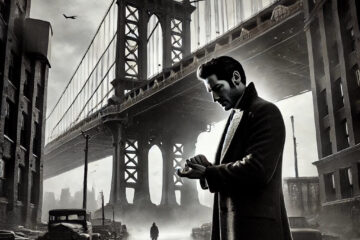In the predawn moments before December 26th, George Washington leads the Continental Army across the mostly frozen Delaware to attack Hessians (German mercenaries from the city-state of Hess). Still hungover from celebrating Christmas, the Americans win what will be known as the Battle of Trenton with only five casualties, while capturing 900 and causing 105 casualties. This painting was released on the 75th anniversary of the battle and the Declaration of Independence.
Washington Crossing the Delaware by Able Gebru
In 1851 Emanuel Leutze completed drawing one of the most patriotic drawings ever. The painting Washington Crossing the Delaware shows George Washington as a leader and main man. The imagery helps the audience see victory, hardships, and unity. The setting of the painting is in a cold climate. The job the rowers are doing in the immense cold shows one of the hardships in this painting. While there are multiple rowers, each of their faces looks determined which helps bring out unity in this painting. There are also many other boats in the background of this painting. All of the boats approaching together, and all the men aboard aim for the same goal of liberty and unity.
Depicted in the painting, George Washington is represented like an angel. The painting glorified Washington. In a dark cloudy sky, there is a yellow light that beams around George Washington. This can help the audience make a connection to a halo on top of an angel.
Washington is depicted war ready and shows victory by just looking at him. Washington’s foot being up shows he is full steam ahead and is pushing for victory. The image shows nationalism by also putting some light to the United States flag. The flag is something people do not mess around with or disrespect. The flag is something people do not take lightly. All the people on the boat believe and support America and are willing to die for the flag. Washington and his troops split up and won against British soldiers. Washington crossing the Delaware was a crucial point in the American Revolution. George Washington’s crossing was a surprise attack the British did not see coming. The painting shows the leadership Washington displays to help through battle. Washington Crossing the Delaware helps the audience visualize victory, hardships, nationalism, liberty, and unity.
Washington Crossing the Delaware by Phoebe Schmitt
On December 26, 1776, a torrential storm raged over Trenton, New Jersey. This is where George Washington famously crossed the Delaware River with his threadbare and tired troops. That night, he would lead a surprise attack on Hessian mercenaries, a battle to be known as the Battle of Trenton. This victory is important because it restored morale in the troops of George Washington, the Commander in Chief of the colonial army. This painting displays the famous crossing of the Delaware River by the colonial army. Washington Crossing the Delaware, an oil painting by Emanuel Leutze, was incredibly important during the time as well. This painting was published when the United States was on the verge of a civil war. Although painted a decade before the war officially started, tensions were high between the states. This painting displayed unity and the greatness of America.
The oil painting references the American Dream, the belief that in America, one can become the richest and best version of themselves through hard work and dedication. As a result of this ideal, Americans established manifest destiny. This belief indicated that America’s “destiny” was to expand its territory westward. In Washington Crossing the Delaware, George Washington can be seen facing West. His men in the boats are also leaning and rowing west. The idea that victory and success lie in the unknown, or the West, is imperative to the idea of American greatness.
George Washington is an example of one of the greatest American success stories: first president, commander in chief, and revolutionary. In this painting, he is shown standing above the rest, by far the tallest object in the painting. Washington Crossing the Delaware is about 149 by 255 inches, or 12 by 21 feet. This painting is a literal representation on how impactful this event was. Quite plainly, it had massive impact. He is also shown in the center middle of the painting, the first thing a person’s eyes are drawn to. These things are done to show how impactful George Washington was in America as a government leader and in this specific battle as a military leader. This was Washington’s first major battle victory in the revolutionary war. George Washington is considered the face of the American Revolution, and therefore was looked up to with profound respect. During the war, he was a symbol of hope; therefore, he has an halo of light around his figure in the painting.
During the time Washington Crossing the Delaware was painted, the United States of America was experiencing excruciating tension between the states. Leutze painted this art piece to show that America is at its greatest is when its unified. During the American Revolution, there were patriots in every colony, and were willing to fight with each other. The first time the thirteen colonies were considered one country was 1776, the beginning of the war. In the painting, the men are all dressed differently: assorted colors, patterns, and styles. This is representative of all the colonies. However, the American flag shown in the painting is furled up, with only four stars showing. This is consequentially because although the colonies were united under law, they were not “American” yet. The war had just begun, and there was no guarantee that “American” would even become a thing. If it was not for the unity of these men, the revolution most likely never would have succeeded.
Washington’s Crossing of the Delaware River by Julia Nackley
This painting of Washington might be one of the most famous paintings of him ever painted. This is a painting of him going to the battle of Trenton to defeat the German troops. The attack happened the day after Christmas and Leutze does a particularly excellent job of showing how cold it was, because there are large pieces of ice all throughout the water.
Washington is the highest person in this painting, his is the center point, he is what your eye goes directly to. The light and dark contrast of colors not only in the main boat, but throughout the background of the painting are used very thoughtfully. The main boat that Washington is on is right in front of a glowing orb of light coming from behind. The light is only directly behind his boat showing it is following him and he is the almost God like figure in this image. The people in the boat along with Washington all have bright colors on as well as Washington, but when you look to the back with the other boats there is less color on the people. Another interesting thing about this painting is the fact that the people in the boats are all different ethnicities. The artists added this very minor but not insignificant detail because it shows that the American Dream, and what they are fighting for is for all different people who claim and want to be Americans.
Although there is much about this painting that is most likely historically accurate there are some things that are not correct. Washington is in the very front boat standing tall and would have been an easy target to hit. This would not be correct because he most likely would have been on land or not in the first boat because they would not have wanted their most important person as the easiest target to hit as the reach land. One other thing that is incorrect about the painting is the flag that is being held up in Washington’s boat was not the flag they would have had at the time of this battle. At the time the stars were not there yet and in the painting you can see the stars on the flag.
Analysis by Margaret Stewart
The image of George Washington sailing in a rowboat on December 26, 1776, depicts American values that will continue to grow as the United States experiences more remarkable events. The piece suggests the strength of America by George Washington, representing the fearless leader that confidently leads his people forward to unknown lands and situations. The artwork depicts the colonists’ trust and faith in Washington’s leadership. At the same time, the work symbolizes the unity of hard-working men and women, which is necessary to achieve their goal of independence from the British. The piece embodies these significant American values through the single image of George Washington and citizens sailing through ice chunks before the Battle of Trenton.
The image positively represents George Washington and the values he displays through his work ethic and ability to command his army and confidently lead the United States to victory. Although, in the beginning, people were unsure of George Washington and his ability to lead, his depiction as a Commander in Chief represents a change in people’s mindsets. In the piece, George Washington is standing on a rowboat looking West physically and metaphorically because he supports the American Revolution for colonists to succeed over injustice. Looking West also symbolizes his strength and confidence in winning the war. George Washington became a popular commander in chief due to his ability to strategize plans, take victory over the British, and lead Americans to success. The image depicts his favoritism through a light in the background surrounding him and the United States flag because he represents America, what it stands for, and the potential for what it could become. The leadership of George Washington set the foundation for the United States of America.
The depiction of George Washington and fellow colonists sailing on rowboats incorporates the American theme of equality. Equality is represented in the image through men and women working together to support a common cause, the American Revolution. However, even though women could not fight in the war, they still helped by providing the continental army with household services and medical care while the men fought on the front lines.
Colonists of all genders came together through acts of kindness and bravery because they were willing to risk their lives for America to be free from the British. These heroic acts symbolize the lengths Americans will go to gain justice and independence throughout the country.
Washington Crossing the Delaware Analysis by Nicholas Woodward
Washington Crossing the Delaware is an oil painting by a German American artist by the name of Emanuel Leutze. The painting depicts George Washington and the Continental Army crossing the Delaware river on Christmas of 1776. The crossing preceded the victory at the Battle of Trenton next day where Washington defeated around 1,500 Hessian soldiers who were garrisoned there.
George Washington is purposefully made to stand out, as he is backed by bright light in the sky around him with the sunlight gleaming on his face and the darkness left in his wake. Washington is looking out towards the future with an onward gaze. He is also placed right front and center in the piece and is the only person in view who is standing. Out of all the people on his boat, Washington is dressed the nicest as well. Behind him, the entire Continental Army is following with cannons, horses, and soldiers for miles. Leutze does a fantastic job of pointing out the most important individual in the piece: Commander-in-Chief George Washington.
Leutze also denotes unity in all the American colonies against the British with the many diverse cultures and countries represented on the boat with George Washington. Directly in front of Washington is a man wearing a Scottish tam, as Scotland did not like England at the time because of the Battle of Culloden in 1746 where the Scots were defeated by the British. Next to Washington is an African American man, behind Washington are a pair of farmers, and at the stern of the boat is a Native American. The distinct cultures in the boat symbolize the differences between each of the American colonies and how they all set aside those differences to fight for independence. The painting inspires a sense of nationalism and unity.
Washington Crossing the Delaware portrays a patriotic scene of the Continental Army meant to spark nationalism and unity among those who see it.
Washington Crossing the Delaware by Kate Hunsberger
On December 26, 1776, Washington and his crew sailed across the Delaware River in an attempt to surprise attack the German Hessians. The German Hessians were a group of mercenary soldiers to the British army during the American Revolution. The Americans prospered in this attack by capturing five hundred men and killing a hundred. The Hessians became an easy target due to their drunkenness from Christmas, the day before. The Americans took advantage of that and launched an attack now known as the Battle of Trenton. The dramatic trek to this battle was later transformed into a painting by Emanuel Leutze known as the Washington Crossing the Delaware. Leutze excels at using different artistic techniques to portray this image.
This image displays not only a historical meaning as Washington really did cross the Delaware, but it also uses techniques to highlight a deeper meaning. Leutze places Washington at the front of the boat standing up to illuminate his authority and leadership. Washington also gives off a sophisticated look compared to the rest of the crewmates. Washington is showing off his figure as everyone else sits beneath him. Leutze does this to show comparison and to again show Washington’s command over his crew. In the painting, Washington faces the west representing his forward work toward the rest of America. The western part of America at this time remained unknown, and Leutze placing Washington that way indicates the forward progress of America.
The lighting of the painting also shows Washington’s drive away from darkness. The light surrounds Washington indicating a triumphant and heroine atmosphere, but the right side of the painting remains as dark and dreary. Lutz does this to foreshadow Washington’s later win giving hope in the revolution.
The surrounding aspects of the painting also influence its meaning. For starters, the surrounding crewmates all have different nationalities Not only were different nations depicted, but women as well are displayed in the image. The depiction gives off strength and unity within Washington’s crew no matter where they came from or who they were. For example, the feathered hats show the influence of the Natives on the American army. The Natives aided the Americans throughout the revolution and the depiction of them shows their unity. Finally, the crew also lacked a common uniform amongst themselves. The disorganization shows how dysfunctional the American army really was. But, in the end, the disorganization did not take away from their abilities and the fight within them.
Washington’s Depiction by Mary Catherine Stanley
Washington Crossing the Delaware was painted in 1851, or the 75th anniversary of the United States/ the Declaration of Independence. The purpose of this painting was to spark a feeling of American Exceptionalism and how great America it is. We should be proud to be
Americans. Even though we are 10 years from a civil war, and tensions in America were rising, Leutze depicts America in the light.
Most specifically, he depicts Washington in a large spotlight. Leutze artistic vision was to place Washington very heroically. To this day, we still think of Washington’s influence. Leutze places Washington in the center, but also a little left. He does this to show Washington’s ability to lead, which is why he is placed in front of the other ships. It is also obvious all the ships and angles are pointed left. If you are thinking of a compass, this would be East. Which is historically accurate, because if Washington was attacking from the water, he would be heading West.
However, one part of the painting that would be historically inaccurate is Washington standing proudly. The painting depicts him very heroically as he stands above everyone with the American Flag behind him, but if you were heading into battle, you probably would not want you leader standing tallest on the boats.
The first detail I noticed in this paining was the lighting. Behind Washington and his men is a very dark gray ominous cloud, but the sky becomes brighter as your eyes move right to left towards Washington. It seems as these men are the light for America, this new nation, parting the dark skies. Washington is placed in the center of this light. When light is projected, the center of light is the source. This painting shows Washington as the source or light, metaphorically, the source of change for America. Because Washington is placed in the center of the light, it also creates this halo effect, for the audience to interpret Washington as being placed in America by God. This is another example of American Exceptional. God gave us Washington, and he is helping us win, meaning America has the favor of God.
While in a time of tension, Leutze successfully depicts American Exceptionalism through the heroic capabilities of Washington. He does this through his specific placement of Washington and use of light.


